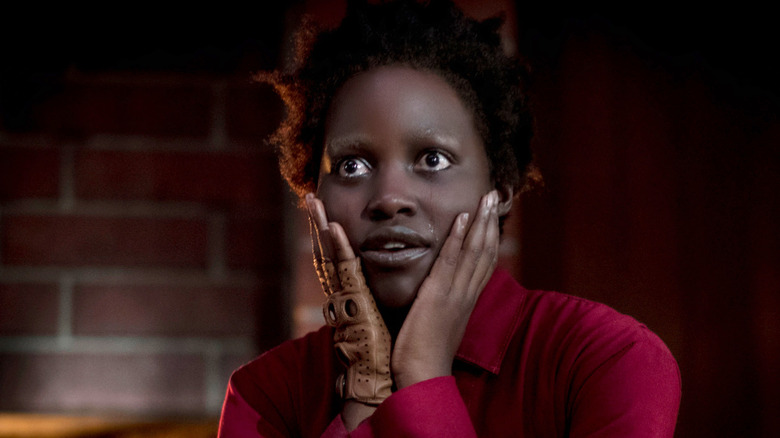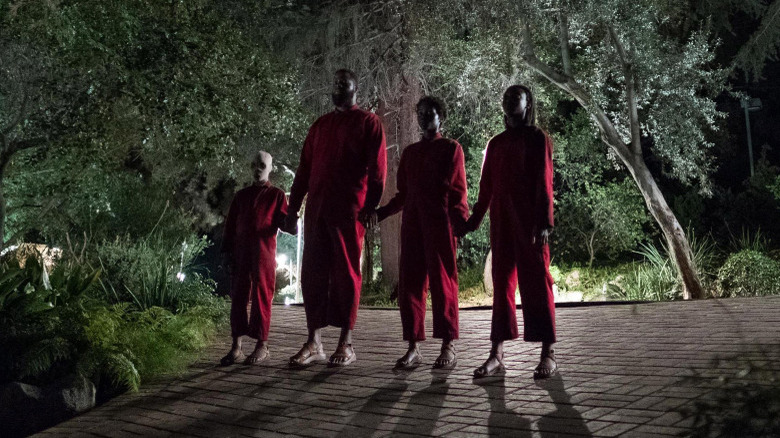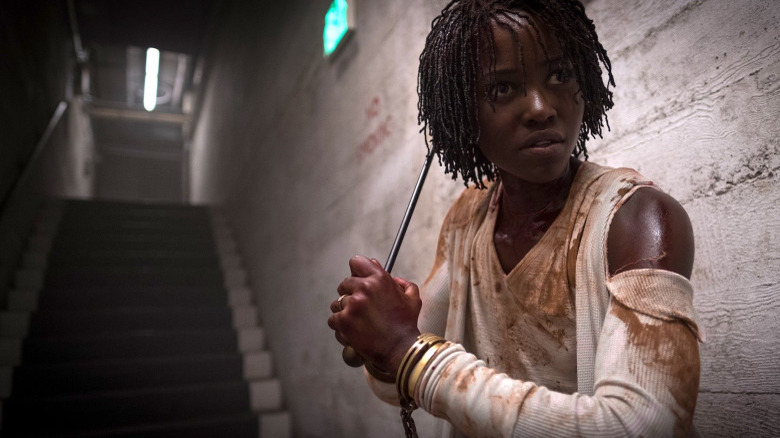How Jordan Peele Used Time To Terrify The Audience In Us
The Jordan Peele-directed horror films "Get Out" and "Us" open with similarly eerie prologues. In "Get Out," a fellow named Andre Hayworth (Lakeith Stanfield) is chatting on his phone while strolling through the suburbs at night, only to be attacked and kidnapped by a masked individual. In "Us," a young girl named Adelaide Wilson (Madison Curry) is visiting the Santa Cruz Beach Boardwalk with her parents when she wanders off, coming face-to-face with her doppelgänger.
From there, both movies jump ahead in time. Where "Get Out" shifts its focus onto a Black photographer named Chris Washington (Daniel Kaluuya) about six months after Andre's kidnapping, "Us" hops to a point where Adelaide (Lupita Nyong'o) is now a grown-up and married with two kids. In both cases, however, the lead characters are on-edge. "Get Out" follows Chris on what he knows all-too-well will be a very awkward weekend trip to meet his white girlfriend's parents at their secluded home. Likewise, "Us" sees Adelaide taking a vacation with her family to Santa Cruz Beach, despite her being traumatized by what happened to her there as a child.
This is where the films deviate when it comes to the ways they generate horror. In "Get Out," much of the suspense comes from the fact that Chris is trapped at his girlfriend's parents' house when he begins to realize he's got more than run-of-the-mill, micro-aggressive white liberals to worry about. In "Us," on the other hand, there's nothing to stop Adelaide and her loved ones from leaving at any given moment, nor are they isolated by physical space the way Chris is. Instead, Peele uses time itself to terrify the audience.
Shifting into Peele time
Foreshadowing aside, the s*** really hits the fan in "Us" when Adelaide and her family are about to go to sleep at their beach house, only for a group of four shadowy individuals to appear in their driveway holding hands. It turns out these creepy intruders are actually the doppelgängers of Adelaide and her family, a group that calls themselves "the Tethered." Yet, even before this information is relayed to Adelaide and, in turn, those watching the movie, Peele quietly ramps up the suspense through his direction.
He broke down his approach for The New York Times, explaining:
"This is the point in the movie where I want the terror to really kick into a new gear for the audience. One of the techniques that I utilized to get that terror was that all of a sudden we go into real time. The movie before this has been going from some time dashes here and there. When we get into this moment where the four family members are standing holding hands outside, then we go into this sort of fluid — we use a lot of the Steadicam with very few edits. Really trying to subliminally signal to the audience that this sort of relentless, real time event has begun and is taking place."
Why Us demands a rewatch
"Us," as you may recall, was well-received by critics yet divided general audiences upon reaching theaters in 2019, and not without reason. As refined and precise as Peele was in the way he crafted the film (as the above comments illustrate), its story does raise a number of seemingly-important questions about the Tethered that it fails to fully answer. Along those same lines, its ending is arguably guilty of leaving a little too much room for interpretation when it comes to the point that Peele is even trying to make.
Speaking as someone who really dug "Us" the first time I watched it but can see where its detractors are coming from, that makes the movie all the more deserving of a revisit in 2022. If anything, I suspect "Us" has aged well these past three years, its ambiguous themes and meaning allowing it to better reflect upon the real-world chaos that has transpired since it first came out. (Certainly, the film's suggestion that people are often their own worst enemies has grown all the more relevant since 2019.) Peele's use of real-time storytelling is also a subtle detail that one can easily miss the first time they see the movie, which is all the more reason to rewatch it before the filmmaker unveils his next original horror vision, "Nope," upon the world.
"Us" is currently available to rent or buy on various streaming platforms. "Nope" opens in theaters on July 22, 2022.


